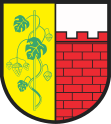Witnica
| Witnica | ||
|---|---|---|

|
|
|
| Basic data | ||
| State : | Poland | |
| Voivodeship : | Lebus | |
| Powiat : | Gorzowski | |
| Gmina : | Witnica | |
| Area : | 8.21 km² | |
| Geographic location : | 52 ° 41 ' N , 14 ° 53' E | |
| Height : | 17 m npm | |
| Residents : | 6822 (December 31, 2016) | |
| Postal code : | 66-460 | |
| Telephone code : | (+48) 95 | |
| License plate : | FGW | |
| Economy and Transport | ||
| Street : | Küstrin - Gorzów Wielkopolski | |
| Rail route : | Kostrzyn – Krzyż Wielkopolski | |
| Next international airport : | Poznań-Ławica | |
Witnica ( German Vietz ) is a town in the powiat Gorzowski of the Lubusz Voivodeship in Poland with about 6800 inhabitants. It is the seat of the town-and-country municipality of the same name with around 13,000 inhabitants.
Geographical location
It is located in the Neumark , 20 km northeast of Küstrin in the Warthebruch and 25 kilometers west of Gorzów Wielkopolski ( Landsberg an der Warthe ).
history
The old fishing village Vietz in Landsberger Land was probably founded by the Templars . It is named after the river through which it flows, the Vietze . In 1261, the place came from the order of the Mark Brandenburg . Margrave Otto IV. Donated various pieces of land to the Kolbatz monastery in 1300 as the basis for the establishment of the Himmelstädt daughter monastery . With the secularization of the monastery in 1539 Vietz became an electoral district village.
In the village on the old trade route (it was later Reichsstrasse 1 Aachen - Berlin - Königsberg (Prussia) , the route of which follows today's Voivodship Road DW 132 ) from Küstrin to Landsberg , the inhabitants lived mainly from agriculture and the river to the Warthe some water mills were resident. The industrialization of Vietz began in the middle of the 18th century. In 1747 a stocking and linen weaving mill was established. For the needs of the Prussian military, a royal ironworks with two blast furnaces was built in 1753 , which initially mainly produced cannons . The iron and steel works were shut down in 1842 and, after being sold in 1855, resumed production as an iron foundry and machine factory.
The importance of the place grew through the construction of the Prussian Eastern Railway (today the Tczew – Küstrin-Kietz border line ), which ran through Vietz from 1857, and the construction of Reichsstrasse 1 from Aachen to Königsberg (today the Polish Voivodship Road 312 (droga wojewódzka 132, the extension of the federal highway 1 )). On the one hand, work came into the region through its construction itself, on the other hand, the town later benefited from these first-class transport connections. Numerous mechanical engineering, wood processing and building material manufacturing companies settled in the village. Ludwig Hartmann, Dampfziegelwerke, Vietz adOstbahn , founded in 1873 , were the largest brickworks in the Frankfurt administrative district in 1925, according to the Vietzer Tageblatt . Vietz in the Landsberg (Warthe) district was at that time the largest rural community in the province of Brandenburg . Vietz has been a city since 1935.
Towards the end of the Second World War , the city was occupied by the Red Army in the spring of 1945 . After the war ended, Vietz was placed under Polish administration and then renamed Witnica . In the period that followed, the entire German population was expelled by the local Polish administrative authority .
Since 2016 there has been a pair of trains a day to Berlin .
Development of the population
| year | 1751 | 1804 | 1875 | 1880 | 1900 | 1933 | 1939 | 2004 | 2016 |
| population | 500 | 888 | 3281 | 3956 | 4139 | 5469 | 5637 | 6858 | 6822 |
local community
The urban-and-rural municipality (gmina miejsko-wiejska) Witnica covers a territory of 278 km² on which 12,570 inhabitants live. In addition to the city itself, this includes 17 villages with school authorities.
Culture
The so-called Signpost Park is located in the community . The exhibits from technology, nature and politics are intended to commemorate the common history of Poles and Germans. He reminds that excessive national pride in one's own people is the cause of many evils between peoples. The collector and actual creator of the park, Zbigniew Czarnuch , was awarded the Georg Dehio Culture Prize by the German Cultural Forum for Eastern Europe in Berlin in October 2009 for his unspectacular, persistent work for Polish-German understanding .
Sons and daughters (selection)
- Georg Heinrich von Priem (1794–1870), Prussian major general.
literature
- W. Riehl and J. Scheu (eds.): Berlin and the Mark Brandenburg with the Margraviate Nieder-Lausitz in their history and in their present existence . Berlin 1861, pp. 475-476.
- Patricia Clough: Aachen - Berlin - Koenigsberg. A journey through time along the old Reichsstrasse 1. Deutsche Verlagsanstalt, Munich 2007, ISBN 978-3-421-04210-1 .
Web links
Individual evidence
- ↑ GenWiki: Vietzer Tageblatt
- ↑ a b c d Michael Rademacher: German administrative history from the unification of the empire in 1871 to the reunification in 1990. Population figures in the Landsberg district (Warthe). (Online material for the dissertation, Osnabrück 2006).
- ↑ Dietrich Schröder: A sage explains the world , in Märkische Oderzeitung , September 24, 2009, p. 10, article online on page no longer available , search in web archives: MOZ 297715
- ^ Between the border posts , accessed July 24, 2010




